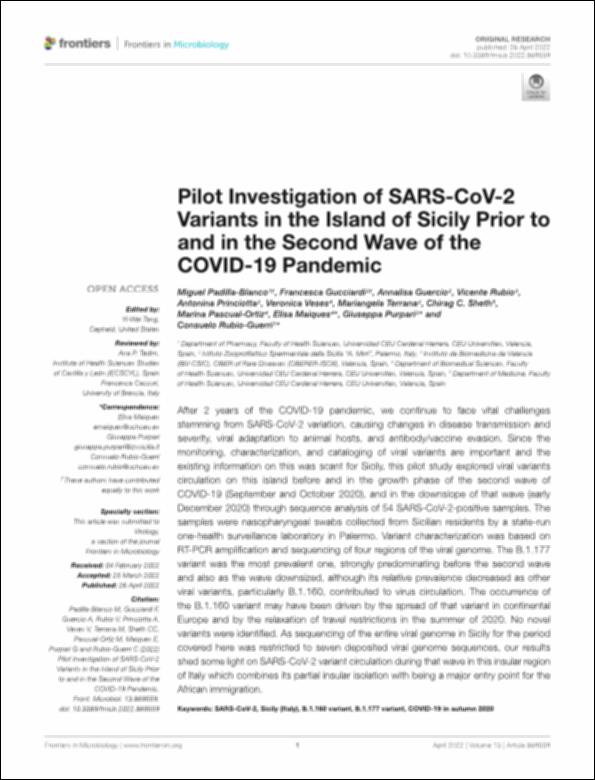Please use this identifier to cite or link to this item:
http://hdl.handle.net/10637/14268Pilot investigation of SARS-CoV-2 variants in the island of Sicily prior to and in the second wave of the COVID-19 pandemic
| Title: | Pilot investigation of SARS-CoV-2 variants in the island of Sicily prior to and in the second wave of the COVID-19 pandemic |
| Authors : | Padilla Blanco, Miguel Gucciardi, Francesca Guercio, Annalisa Rubio Zamora, Vicente Princiotta, Antonina Veses Jiménez, Verónica. Sheth Shah, Chirag Chandrakant Pascual Ortiz, Marina Maiques Fernández, Elisa Rubio Guerri, Consuelo |
| Keywords: | COVID-19 Pandemic, 2020-; COVID-19.; Pandemia de la Covid-19, 2020-; SARS-CoV-2 (Virus); COVID-19 (Disease) |
| Publisher: | Frontiers Media |
| Citation: | Padilla-Blanco, M., Gucciardi, F., Guercio, A., Rubio, V., Princiotta, A., Veses, V., Terrana, M., Sheth, C. C., Pascual-Ortiz, M., Maiques, E., Purpari, G. & Rubio-Guerri, C. (2022). Pilot investigation of SARS-CoV-2 variants in the island of Sicily prior to and in the second wave of the COVID-19 pandemic. Frontiers in Microbiology, vol. 13, art. 869559 (26 apr.). DOI: https://doi.org/10.3389/fmicb.2022.869559 |
| Abstract: | After 2 years of the COVID-19 pandemic, we continue to face vital challenges stemming from SARS-CoV-2 variation, causing changes in disease transmission and severity, viral adaptation to animal hosts, and antibody/vaccine evasion. Since the monitoring, characterization, and cataloging of viral variants are important and the existing information on this was scant for Sicily, this pilot study explored viral variants circulation on this island before and in the growth phase of the second wave of COVID-19 (September and October 2020), and in the downslope of that wave (early December 2020) through sequence analysis of 54 SARS-CoV-2-positive samples. The samples were nasopharyngeal swabs collected from Sicilian residents by a state-run one-health surveillance laboratory in Palermo. Variant characterization was based on RT-PCR amplification and sequencing of four regions of the viral genome. The B.1.177 variant was the most prevalent one, strongly predominating before the second wave and also as the wave downsized, although its relative prevalence decreased as other viral variants, particularly B.1.160, contributed to virus circulation. The occurrence of the B.1.160 variant may have been driven by the spread of that variant in continental Europe and by the relaxation of travel restrictions in the summer of 2020. No novel variants were identified. As sequencing of the entire viral genome in Sicily for the period covered here was restricted to seven deposited viral genome sequences, our results shed some light on SARS-CoV-2 variant circulation during that wave in this insular region of Italy which combines its partial insular isolation with being a major entry point for the African immigration. |
| Description: | Este artículo se encuentra disponible en la siguiente URL: https://www.frontiersin.org/articles/10.3389/fmicb.2022.869559/full En este artículo de investigación también participan: Francesca Gucciardi, Annalisa Guercio, Vicente Rubio, Antonina Princiotta, Verónica Veses, Mariangela Terrana, Chirag C. Sheth, Marina Pascual-Ortiz, Elisa Maiques, Giuseppa Purpari y Consuelo Rubio-Guerri. Este artículo de investigación se encuentra en la sección "Virology". |
| URI: | http://hdl.handle.net/10637/14268 |
| Rights : | http://creativecommons.org/licenses/by/4.0/deed.es |
| ISSN: | 1664-302X (Electrónico) |
| Language: | es |
| Issue Date: | 26-Apr-2022 |
| Center : | Universidad Cardenal Herrera-CEU |
| Appears in Collections: | Dpto. Ciencias Biomédicas |
Items in DSpace are protected by copyright, with all rights reserved, unless otherwise indicated.


